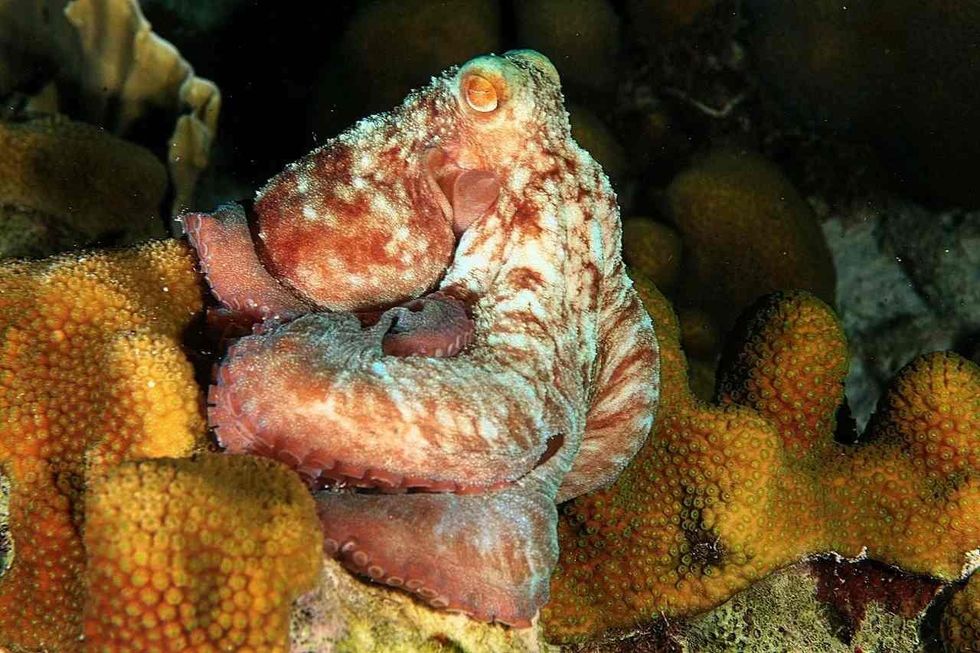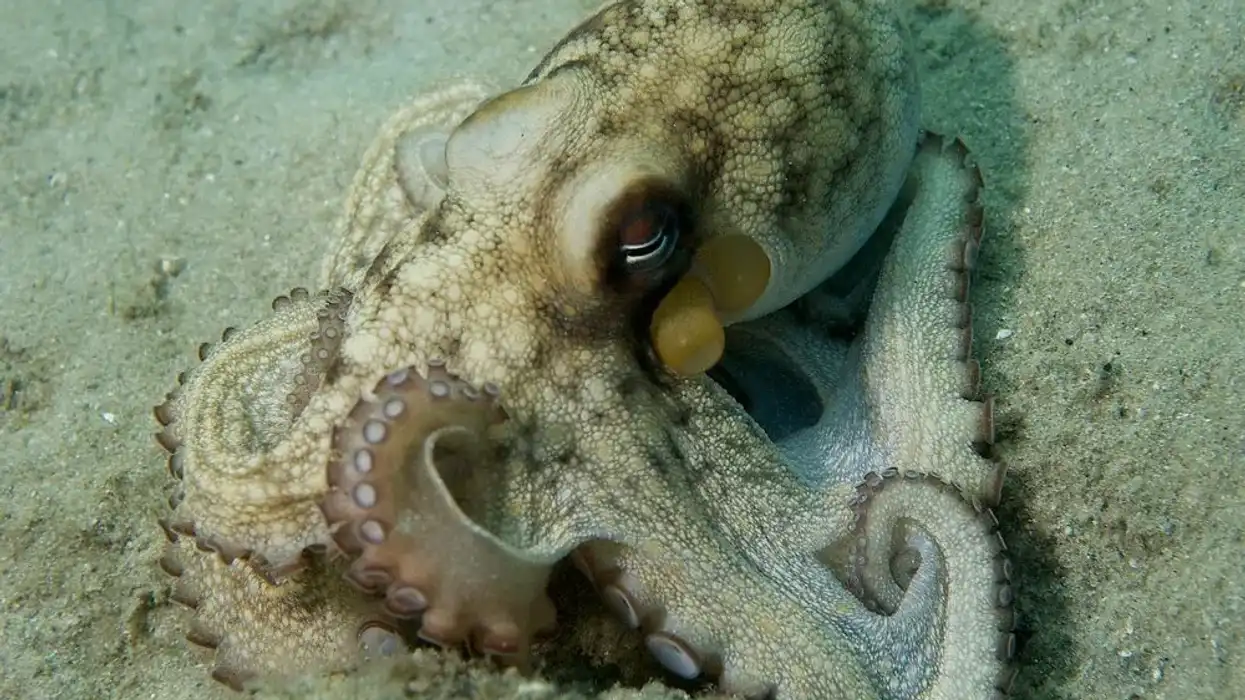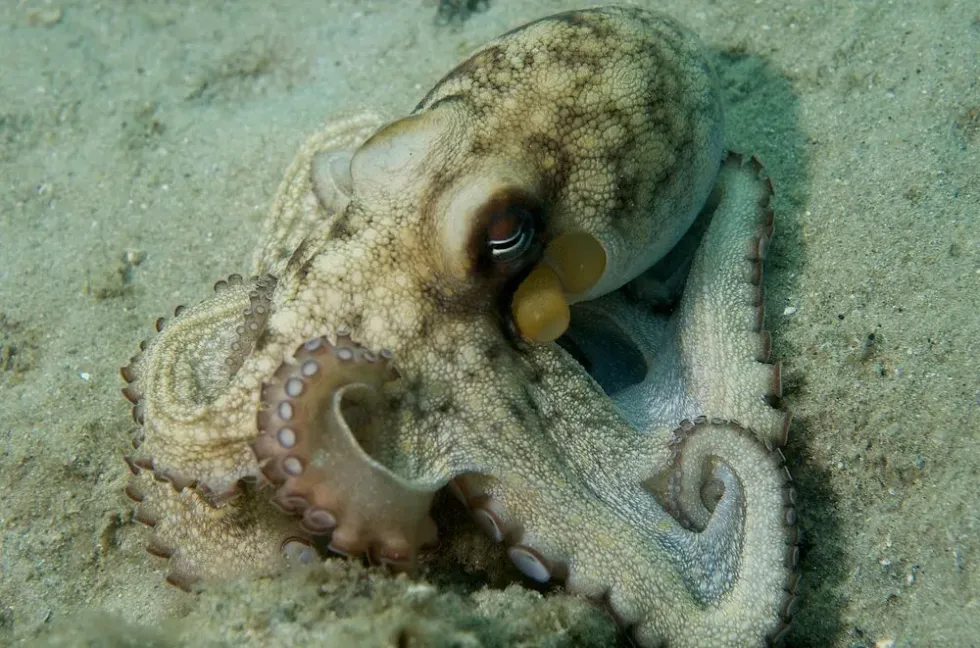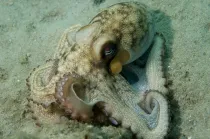Fun Caribbean Reef Octopus Facts For Kids

These vibrantly colored octopuses hold the title of being the smartest of all invertebrates. They are unique in the sense that they can change the color and texture of their body to blend into their surroundings.
This not only helps them to evade their predators but also to search for their prey sneakily.
Thankfully, they are not a threatened species as of now, even though, humans have been hunting them for food forever. However, experts have stated a concern as their existence is directly tied to the existence of coral reefs and as the latter continues to be endangered, the existence of this beautiful octopus can become questionable too.
Any living organism plays a direct part in the well-being of others, and if the existence of one is threatened, others might have to face the consequences presented by the ecosystem as well.
This is why it is important to keep their numbers stable before it is too late. Read on to learn more interesting facts about this marine creature.
If you like reading about marine animals, check out vampire squid facts and mimic octopus facts.
Caribbean Reef Octopus Interesting Facts
What type of animal is a Caribbean Reef Octopus?
As evident by their names, the Caribbean reef octopus is a type of octopus that is found around the Caribbean range of the Atlantic Ocean. They are known as the most intelligent of all invertebrates with an ability to merge into their surroundings that can fool anyone.
What class of animal does a Caribbean Reef Octopus belong to?
Like all octopuses, the Caribbean reef octopuses are Cephalopods. They can change not only the color pattern of their body but also the texture. This helps them fool their natural predators by blending into the coral reefs where they are commonly found while providing them with a unique trait.
How many Caribbean Reef Octopuses are there in the world?
It is hard to say just how many Caribbean reef octopuses are there in the world, but as they are not enlisted in the IUCN Red List of Threatened Animals, it is safe to assume that they are not facing the threat of extinction any time soon.
This species of octopuses is unique because they can change the color of their body to blend into their surroundings and the texture of their body.
Where does a Caribbean Reef Octopus live?
They are found around the shallow waters of the neotropical region of the world. Namely, in the Caribbean, the Gulf of Mexico, Florida, the Bahamas, and throughout the western part of the Atlantic Ocean as well as in the Pacific Ocean.
What is a Caribbean Reef Octopus's habitat?
They are shy creatures living in the shallow waters of the neotropical region. They are found around the coral reefs making dens for themselves in the crevices which they are very territorial about.
Who do Caribbean Reef Octopuses live with?
Caribbean reef octopuses are known to mostly live alone and only interact with others during the mating season. They are extremely solitary and defend their dens fiercely, even going as far as killing and eating other octopuses that drift too close to their territory.
There are known to spend most of their lives in a single den and only change it if they are threatened by intruders they cannot fight off. They are shy creatures and almost always return to their dens after catching their prey.
How long does a Caribbean Reef Octopus live?
The Caribbean octopus is known to live for about 10-12 months in the wild, and about 10-17 months when in captivity. However, their lifespan can be cut short in captivity by various diseases.
The males often die after giving their hectocotylus to the females for mating purposes, while the females tend to die after they lay eggs and make sure that they are in a safe place to hatch when the time comes.
How do they reproduce?
They are monogamous and only mate once in their lives. These marine octopuses have two known ways of mating.
Either the male octopuses mate with the female and release the sperm inside their body to fertilize the eggs, or they give their hectocotylus to the females and the females store it inside their mantle until the eggs are ready to be fertilized and then extract the sperm from their mantle.
These octopuses lay about 300-500 eggs per pregnancy. The male octopuses usually die a few months after they give their hectocotylus to the female, while the female generally dies after laying eggs and making sure that they are in a safe place until the eggs hatch.
What is their conservation status?
The Caribbean reef octopus is not listed in the IUCN Red List of Threatened Animal Species, so it is safe to assume that its population is stable enough in its natural habitat. However, humans have been hunting these beautiful marine creatures for a long time, which has somewhat decreased their population.
Sharks and stingrays are known to prey on them and that is another reason why their population is declining in some places.
Caribbean Reef Octopus Fun Facts
What do Caribbean Reef Octopuses look like?

This species of marine octopuses are a vibrant blue-green with brown and red spots peppered through their bodies. They are known to have a special type of cell in their bodies called chromatophores that help them to blend into their surroundings while successfully fooling their predators.
This reef octopus is known to have eight long legs, or tentacles, of different sizes, and a mantle that is large with dark-colored eyes. The longest pair of legs, namely the second and the third one is known for growing almost five times bigger than the size of the mantle.
All legs come with suckers divided into two rows that help these creatures catch their prey.
Their teeth are divided into seven rows. Interestingly, the young of these animals look like miniature versions of the adults.
How cute are they?
More than cute, this creature is quite exotic-looking with its iridescent aquamarine color and chunky-looking mantle. Their unique ability to change colors comes with a wide range, they can go from crimson red to green in no time at all.
How do they communicate?
Octopuses are extremely smart animals, in fact, the smartest among all invertebrates in the ocean ecology. They have particular organisms that help them to use vocalizations that are only comprehensible to their species.
They also use the chromatophores and iridocytes in their skin to change the pattern of colors and reflect light off their skin to communicate among their kind. These blue-green predators are also known to use sound to locate their prey.
How big is a Caribbean Reef Octopus?
The octopus briareus is one of the smaller species of octopus in appearance, and its range length is only about 2.13-4.72 in (5.4-12 cm), which is about the same size as a rose tarantula.
How fast can a Caribbean Reef Octopus move?
It is hard to say just how fast this blue-green marine octopus can move, but, as octopuses, in general, are known for being fast swimmers with a top speed of 25 mph, it is possibly safe to assume that the Octopus briareus can also move quite fast.
How much does a Caribbean Reef Octopus weigh?
This species of reef octopus is not known for being particularly heavy given their small bodies. On average, they only weigh about 2.2-3.3 lb (1-1.5 kg).
What are the male and female names of the species?
Octopuses, in general, do not have sex-specific names for males or females.
What would you call a baby Caribbean Reef Octopus?
Like all other species of octopus, the babies of octopus briareus are called larvae. The babies of this marine creature are born looking like a miniature versions of the adults, and they drift around the coral reefs in search of prey.
What do they eat?
The octopus briareus is known to be a nocturnal species that searches for its food during the night. This helps them to stay away from their predators and also helps them in hunting for their food.
Their primary food habit consists of shrimp, spiny lobsters, crabs, and small fish.
However, Caribbean reef octopuses have been known to indulge in cannibalism as well, that is, they are known to eat members of their species. Their teeth and suckers are divided into seven and two rows respectively which helps them to catch their prey.
These marine creatures are known to often surprise their prey by launching themselves over coral reefs, while sometimes this predator is known to stalk its prey from behind and wrap its front tentacles around the prey to capture it.
The amount of food they take in completely depends on the sources of food available as well as on the temperature of the water. The female reef octopus decreases the food amount it eats by almost 50% about two weeks before laying eggs.
Are they poisonous?
Although a study says that all octopuses are poisonous, the octopus briareus is not known for its particularly high venom flow. However, this predator is the smartest of all invertebrates in the ocean ecology, so, they are more than equipped to fight off potential threats.
They are known to discharge a kind of ink cloud as a deterrent to their predators which tastes extremely bad and is enough to throw the predator off course for a short time.
Would they make a good pet?
Octopuses in general make appealing pets, and this reef octopus is no different. With their vibrant appearance and beautiful tentacles, they can add glamour to your aquarium.
You should only keep in mind that the tank size should be around 50-75 gallons and the temperature should be around 72°-78° F (22-25 C). They also have a knack for escaping so a solid roof would be helpful.
Feeding them is also quite easy as even the larvae are pretty well developed and can consume crustaceans from the beginning. Other than that, you can decorate the tank with coral reefs to make them more comfortable in their surroundings.
Did you know...
Caribbean reef octopuses are the smartest among all invertebrates in the ocean ecology.
They have specialized skin cells called chromatophores that enable them to change the color and texture of their body. The range of colors is so varied they can change from crimson red to blue-green in no time at all.
Are Caribbean Reef Octopuses endangered?
These octopuses are not endangered as of now. However, experts have stated a concern regarding their future as their existence is directly tied to the existence of coral reefs and as they continue to be endangered, there is a chance that this species of octopuses will be threatened as well due to the destruction of their habitat.
What is the longest-living Octopus?
These octopuses do not live long, only about 10-12 months in the wild and about 10-17 months in captivity.
They only mate once in their lives, and the males tend to die after a few months of giving their hectocotylus to the females while the females are prone to die after laying eggs and making sure that they are safe enough to hatch on their own.
An octopus from the deep part of the sea, Graneledone boreopacifica, is known to live the longest among all types of octopus, with a lifespan of about 53 months which is a record of its own.
Here at Kidadl, we have carefully created lots of interesting family-friendly animal facts for everyone to discover! Learn more about some other cephalopods including giant Pacific octopus facts and coconut octopus facts.
You can even occupy yourself at home by coloring in one of our free printable caribbean reef octopus coloring pages.
We Want Your Photos!
More for You
Bachelor of Arts specializing in Journalism and Mass Communication, Postgraduate Diploma in Sports Management

Moumita DuttaBachelor of Arts specializing in Journalism and Mass Communication, Postgraduate Diploma in Sports Management
A content writer and editor with a passion for sports, Moumita has honed her skills in producing compelling match reports and stories about sporting heroes. She holds a degree in Journalism and Mass Communication from the Indian Institute of Social Welfare and Business Management, Calcutta University, alongside a postgraduate diploma in Sports Management.
Bachelor of Science specializing in Systems Engineering

Oluwapelumi IwayemiBachelor of Science specializing in Systems Engineering
Iwayemi is a creative content writer and editor studying for a Bachelor of Science specializing in Systems Engineering from the University of Lagos. He is skilled in research and has experience writing and editing content for different organizations.
Disclaimer
1) Kidadl is independent and to make our service free to you the reader we are supported by advertising. We hope you love our recommendations for products and services! What we suggest is selected independently by the Kidadl team. If you purchase using the Buy Now button we may earn a small commission. This does not influence our choices. Prices are correct and items are available at the time the article was published but we cannot guarantee that on the time of reading. Please note that Kidadl is a participant in the Amazon Services LLC Associates Program, an affiliate advertising program designed to provide a means for sites to earn advertising fees by advertising and linking to Amazon. We also link to other websites, but are not responsible for their content.
2) At Kidadl, we strive to recommend the very best activities and events. We will always aim to give you accurate information at the date of publication - however, information does change, so it’s important you do your own research, double-check and make the decision that is right for your family. We recognise that not all activities and ideas are appropriate for all children and families or in all circumstances. Our recommended activities are based on age but these are a guide. We recommend that these ideas are used as inspiration, that ideas are undertaken with appropriate adult supervision, and that each adult uses their own discretion and knowledge of their children to consider the safety and suitability. Kidadl cannot accept liability for the execution of these ideas, and parental supervision is advised at all times, as safety is paramount. Anyone using the information provided by Kidadl does so at their own risk and we can not accept liability if things go wrong.
3) Because we are an educational resource, we have quotes and facts about a range of historical and modern figures. We do not endorse the actions of or rhetoric of all the people included in these collections, but we think they are important for growing minds to learn about under the guidance of parents or guardians.







